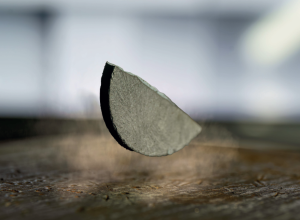Claims of a room-temperature, ambient-pressure superconductor recently kicked up a storm on social media. As the dust settles, we take stock of what this experience can teach us.
On 23 July, two preprints (https://arxiv.org/abs/2307.12008; 2023; and https://arxiv.org/abs/2307.12037; 2023) with overlapping authors appeared on the arXiv that claimed to show superconductivity at room temperature and ambient pressure in copper-doped Pb10(PO4)6O. More colloquially, this material is called LK-99 after two of its inventors and the year that it was first synthesized. Although there have been many such claims in the past, something different happened this time: people on social media got incredibly excited.

In the weeks since then, various labs around the world have scrambled to do replication experiments and theoretical simulations, and the current consensus appears to be that there is no zero-resistance state in this material. Instead, a phase transition caused by the rearrangement of impurities seems to lead to the drop in resistance that the preprints showed. A video uploaded with one of the preprints that purported to show the sample levitating — evidence for the perfect diamagnetic response that superconductivity entails — is probably explained by more mundane magnetism. But we note that, at the time of writing, the authors still stand by their results.
However, for a short period of time, there was a flurry of interest both from professional physicists and from more casual observers. People picked the data apart, discussed the technological and societal implications if the results were correct, and even gave advice for speculation on financial markets.
Other disciplines in physics experience such surges of interest now and again, be it for a potential detection of a new particle at a collider or data from a telescope that suggests something fresh about exotic objects in distant galaxies. But this is an unfamiliar situation for many in condensed-matter physics and materials science, as the work done by these communities tends not to fire the imagination of the general public so readily.
But the response by the research community was commendable. Initial sceptical feelings of “we’ve been here before” were promptly superseded by the patient work of explaining the physics to people who don’t have a background in the subject. And, while there were undoubtedly some under-informed opinions shared on social media, the majority of commentary was detailed, constructive and educational. Many were involved, but Inna Vishik (@InnaVishik on X), Leslie Schoop (@SchoopLab), and Michael Fuhrer (@MichaelSFuhrer) deserve particular recognition for taking the time to translate the technical details to make the ideas more accessible.
It is also worth reflecting on the role that preprints have played in the story. One can certainly argue that many of their advantages were on full display here: rapid dissemination of results, a low barrier for entry for anyone who wanted to contribute to the discussion, and a quick resolution of the debate. Also, without the preprints and resulting replication experiments, some of the other interesting facets of the material’s behaviour would not have been discovered.
But one can also argue that exceptional and high-profile cases such as this do not necessarily translate well into normal practice. In some sense it was fortuitous that the material in question is relatively straightforward to synthesize: many labs around the word had the equipment and expertise to get involved and that will not always be the case. Also, tens of groups put a substantial amount of effort into verifying the initial results and that is somewhat inefficient.
In contrast, traditional peer review would probably have handled the situation differently. It is likely that referees would have had a string of technical questions for the authors to respond to, and would probably have suggested extra measurements that would make the data more robust. Either the authors would have been able to do those or not, and that would have decided the fate of the paper. Although it would have taken longer, the amount of work required in that situation would have been much less.
But finally, returning to the unusual amount of attention that this story generated for condensed-matter physics, it is likely that this would not have happened without the preprints. Regardless of the outcome for the superconductivity in LK-99, it was a helpful opportunity to have a meaningful discussion of the physics and to highlight the exciting potential impact of contemporary research.
So, it would be ideal if the community could find a way to keep its new-found fans engaged. Collectively, we have started to unpack fascinating physical concepts — magnetism, transport, band structure — and their implications for technology in a way that it seems many found more accessible than they usually are. But this story also addresses gritty solid-state physics problems such as the role of impurities and the details of what makes a material practically useful. These issues are often glossed over, but in this case they could not be ignored.
As negative as social media can often be — not all publicity is good publicity, after all — the story of LK-99 shows that thoughtful, constructive engagement can be successful. So, we leave it as a challenge — to ourselves as much as anyone — to participate.
Rights and permissions
About this article
Cite this article
Party like it’s LK-99. Nat. Phys. 19, 1222 (2023). https://ift.tt/2eoajTp
-
Published:
-
Issue Date:
-
DOI: https://ift.tt/2eoajTp
"like this" - Google News
September 11, 2023 at 10:28PM
https://ift.tt/CO79VHL
Party like it’s LK-99 - Nature.com
"like this" - Google News
https://ift.tt/duh2cV9
Shoes Man Tutorial
Pos News Update
Meme Update
Korean Entertainment News
Japan News Update
No comments:
Post a Comment